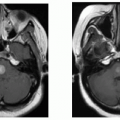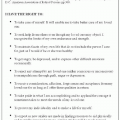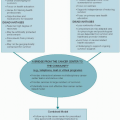Dyspnea
Dyspnea occurs in 29% to 90% of terminally ill patients and is the most common severe symptom as death approaches (
9,
10,
11,
12,
13). Although it is more common in patients with pulmonary disorders, 23.9% of dyspneic patients in the National Hospice Study did not exhibit cardiac or pulmonary disease (
11). Dyspnea is also reportedly more common in children dying of cancer, occurring in 80% of such patients (
14,
15). Dyspnea in terminally ill patients derives from five primary causes, namely:
Existing disease (i.e., chronic obstructive pulmonary disease [COPD] and congestive heart failure)
Acute superimposed illness (i.e., pneumonia and pulmonary embolus)
Cancer-related complications (i.e., pleural effusion, lymphangitic carcinomatosis, tumor-induced bronchial obstruction, and ascites)
Effects of cancer therapy (i.e., radiation and chemotherapy-induced pulmonary fibrosis), and
Miscellaneous causes (i.e., anemia, uremia, and anxiety) (
9,
13,
16).
As with any symptom, the treatment of dyspnea should address any easily correctable underlying cause, all the while recognizing and considering the limited life expectancy of the imminently dying patient and the invasiveness and discomfort of the proposed therapeutic interventions. Consequently, for most patients near death, opioids, benzodiazepines, phenothiazines, and corticosteroids are the mainstays of therapy (
2,
7,
8,
9,
12,
13,
16,
17).
Opioids purportedly relieve dyspnea by altering the perception of breathlessness (
10,
18), decreasing ventilatory response to hypoxia and hypercapnia (
10,
19), and reducing oxygen consumption at rest and with exercise (
10,
20). Controlled trials and anecdotal case reports on the use of systemic opioids in the treatment of malignant and COPDassociated dyspnea have generally demonstrated a reduction in dyspnea (
10,
17,
21,
22,
23,
24,
25), including a
Cochrane Review that further confirmed the benefit of oral and parenteral opioids in improving dyspnea in patients with life-limiting disease (
26,
27,
28). In 2008, opioids were endorsed as the preferred drug to control dyspnea by the American Thoracic Society and the American College of Physicians (
29,
30) followed by The American College of Chest Physicians in 2010 (
31). Although morphine preparations are generally utilized, any opioid should potentially alleviate dyspnea (
Table 53.1). Opioids can be administered orally, rectally, sublingually, subcutaneously, intravenously, and by inhalation, but during the final hours of life when the ability to swallow declines and consciousness wanes, rectal, subcutaneous, and intravenous routes are more commonly used.
Inhalation of opioids is a unique and innovative approach to drug delivery. Controlled trials have revealed conflicting results (
17,
21,
25,
32,
33,
34,
35,
36,
37,
38,
39,
40), including a
Cochrane Review that showed no benefit of nebulized morphine over nebulized saline (
26,
27,
28,
41), but anecdotal reports have generally been favorable (
13,
42,
43,
44). In addition, a recent study by Bruera
et al. noted that nebulized morphine was as good as subcutaneous morphine in relieving dyspnea in patients with cancer; however, only 11 patients were included in the study, limiting its value (
45). It is postulated that inhaled opioids exert their effect by means of opioid receptors that have been identified in the bronchial mucosa, as pharmacokinetic studies suggest that systemic bioavailability of nebulized morphine is extremely poor, varying from 4% to 8% (
21,
35,
46). However, opioids may also stimulate histamine release from pulmonary mast cells and precipitate bronchospasm, worsening terminal dyspnea. Because this complication is usually a first-dose effect, careful observation is required during initial administration and may warrant the prophylactic use of an antihistamine such as diphenhydramine. Although studies are generally nonsupportive and further research with randomized controlled trials is unquestionably warranted, in the dyspneic patient near death, nebulized opioids may be efficacious and worth a trial in an attempt to reduce breathlessness and assuage the horrific fear of suffocation when all other palliative measures have failed.
Benzodiazepines have been frequently utilized in dyspnea primarily when a component of anxiety is involved. However, studies and anecdotal reports are contradictory (
17), with most well-designed randomized controlled trials failing to find significant benefit (
47,
48,
49,
50). Nevertheless, benzodiazepines are frequently beneficial in reducing dyspnea, particularly during the final days of life (
51), and are increasingly used in hospice and palliative care programs. Midazolam when used as an adjuvant to opioids showed significant benefit in the relief of dyspnea when compared with opioids as a single agent (
52) without further risk of respiratory depression (
53). Buspirone, a popular nonbenzodiazepine anxiolytic and serotonin agonist, has been shown to relieve dyspnea in patients with anxiety and COPD at a dose of 15 to 45 mg daily (
54). Because of its delayed onset of action, it may be of limited use in actively dying patients. Although not a benzodiazepine, the neuroleptic chlorpromazine has been used in dyspnea refractory to other medications. It appears to reduce air hunger and anxiety with minimal side effects (primarily sedation and hypotension) and has been efficacious in patients near death (
9,
55,
56).
Although corticosteroids are useful when bronchospasm is associated with inflammation, most studies suggest that only 20% to 30% of patients with COPD show improvement
with corticosteroid therapy. In the final days of life, corticosteroids are most useful when prescribed for dyspnea associated with airway obstruction, lymphangitic carcinomatosis, radiation pneumonitis, and superior vena cava syndrome (
9,
16). Corticosteroids can be administered orally, rectally, subcutaneously, intravenously, and by inhalation. Although side effects are of concern during chronic use, such concerns are negated by short-term use in dying patients.
Other medications are also available to attenuate dyspnea in the dying patient. These include diuretics, bronchodilators, and inhaled anesthetics. Oral and intravenous diuretics are useful when pulmonary edema and ascites contribute to dyspnea. The diuretic furosemide can also be administered through inhalation in a dose of 20 mg every 2 to 4 hours as needed and appears to reduce dyspnea, irrespective of the underlying etiology (
57,
58,
59,
60). Although bronchodilators are best utilized in patients with a bronchospastic component to dyspnea (i.e., asthma and COPD with reactive airways), these drugs are frequently used when there is little-to-no evidence of bronchospasm and appear to provide subjective reduction of dyspnea in many patients. The use of adrenergic agonist bronchodilators, such as albuterol and metaproterenol, should be tempered by the possibility of resultant agitation, tremor, and heightened anxiety, potentially aggravating terminal dyspnea (
9).
Nebulized anesthetics have been used infrequently for dyspnea in dying patients. In a study comparing nebulized saline and lidocaine, saline exerted a greater effect on the reduction of breathlessness (
35,
61). However, nebulized anesthetics have been useful for cough and may be considered when persistent coughing contributes to or aggravates dyspnea (
35).
Nonpharmacologic interventions that are useful for terminal dyspnea include oxygen, a bedside fan, thoracentesis for pleural effusion, and paracentesis for ascites. The role of oxygen therapy in reducing dyspnea in patients near the end of life is somewhat controversial. In hypoxemic patients with disorders such as COPD, congestive heart failure, or pulmonary fibrosis, most studies suggest that there is a significant symptomatic improvement (
21,
32,
62). In patients without hypoxemia, however, its use is not advantageous (
35,
63,
64). Even so, the medical symbolism inherent in oxygen therapy may alleviate dyspnea by way of a placebo effect and should be considered in actively dying patients (a nasal cannula is better tolerated than a mask in most patients) (
9,
49). Moreover, oxygen therapy may provide many family members with the symbolic solace that “something is being done” to help their loved one, in spite of the fact that oxygen may actually provide only little therapeutic benefit.
A bedside fan may also be useful in alleviating dyspnea by reportedly stimulating thermal and mechanical receptors of the trigeminal nerve (V2 branch) in the cheek and nasopharynx, altering the central perception of breathlessness (
9,
55,
65,
66). The fan should be placed at the bedside, set on a low speed, and directed at the patient’s face (
9).
Thoracentesis and paracentesis may be useful when pleural effusion and ascites contribute to dyspnea (particularly if previous drainage has reduced dyspnea). In the final days of life, however, generally other strategies should be utilized unless noninterventional approaches have failed and breathlessness aggravates suffering. An indwelling thoracentesis or paracentesis catheter may obviate the need for repeated and painful intermittent thoracenteses and paracenteses and should be considered in recurrent and disabling pleural effusions and ascites depending on estimated life expectancy.
Death Rattle
In the last 24 to 48 hours of life, most patients retain secretions in the back of the throat that produces a gurgling type of respiration frequently referred to as the death rattle (
9,
67). The presence of these enhanced secretions is felt to predict death within 48 hours in over 75% of patients (
68). Fortunately, the patient is usually unaware of the noise. It can, however, be very disturbing to family members. Oropharyngeal suctioning is usually provided, but gagging and coughing may generate patient discomfort and further distress for relatives and caregivers. Instead, treatment with anticholinergic drugs is recommended to desiccate bronchial secretions and abolish the need for suctioning. Suggested medications include atropine, glycopyrrolate, scopolamine, and hyoscyamine (
Table 53.2) (
9,
16,
69). In one study, subcutaneous scopolamine was more immediately efficacious when compared with subcutaneous glycopyrrolate; however, glycopyrrolate has a longer duration of action (
26,
36). Nevertheless, most anticholinergic medications work relatively well and are widely used in clinical practice, although the overall efficacy has been challenged by a recent
Cochrane Review (
70). These antisialagogues do not dry up secretions that are already present, and they should therefore be used at the first sign of noisy respirations (
7). In addition, placing patients in a lateral recumbent position with the head slightly elevated may help reduce the pooling of secretions and diminish noisy respirations (
2), as may discontinuing parenteral and enteral infusions whenever possible (
14).








